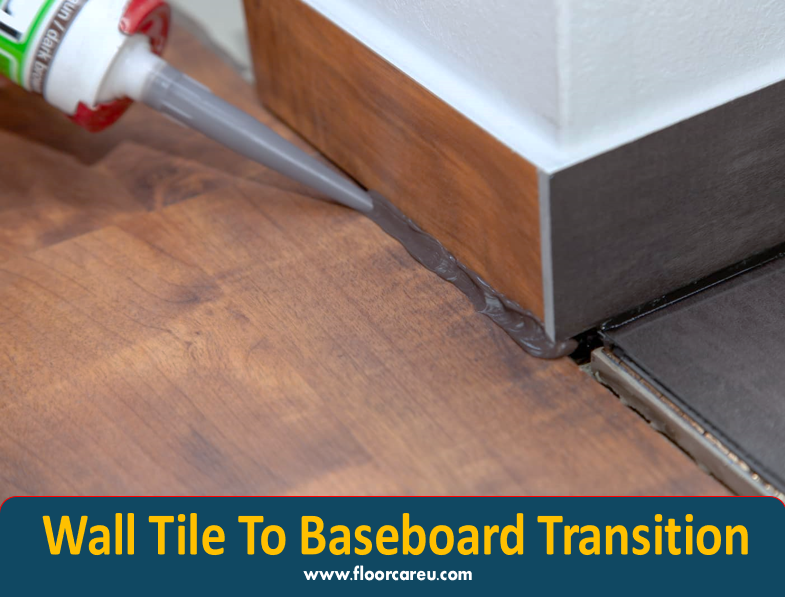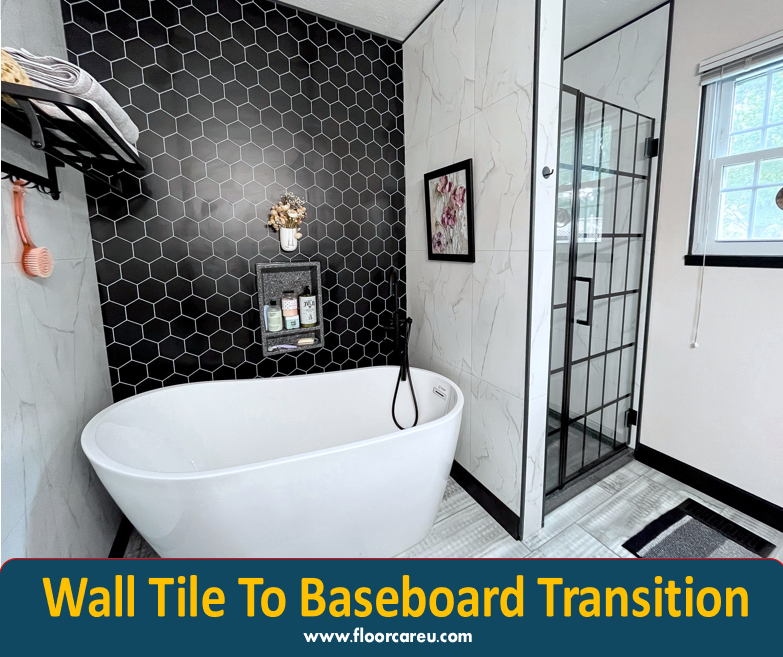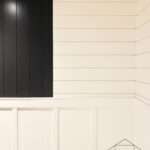Wall Tile To Baseboard Transition: The best way to transition baseboards to tile is by using a caulk with ¼” gaps, avoiding sanded grout. This provides a seamless and professional finish between the baseboard and tile.
Generally, the baseboard finishes the bottom of the sheetrock and protects it. If you have tile on the wall, it serves the same purpose as the baseboard, and using an additional baseboard may not be necessary. However, it is recommended to install tile under baseboards for a cleaner and more polished look.
When transitioning from tile to baseboard, one option is to belt sand a piece of the base to go over the tile if running the baseboard over the tile is not desired. Following these techniques can achieve a smooth and attractive transition between your wall tile and baseboard.
Choosing The Right Materials
When transitioning from wall tile to baseboard, choosing the right materials is one of the most important aspects to consider. This ensures a seamless and visually appealing transition that adds a professional touch to your space. This section will explore the essential factors to consider when selecting suitable baseboards and options for tile trim.
Selecting Suitable Baseboards
Choosing the right baseboards is the first step in achieving a flawless wall tile-to-baseboard transition. Here are some key points to consider:
- Elevation: Ensure that the baseboard’s height matches the wall tile height for a uniform and balanced look.
- Material: Opt for a baseboard material that complements the wall tile, such as wood, vinyl, or PVC.
- Style: Select a baseboard style that complements the overall aesthetic of your space, whether it’s traditional, modern, or somewhere in between.
- Finish: Choose a finish that enhances the visual appeal of the baseboard, such as painted, stained, or natural wood grain.
Options For Tile Trim
Tile trim is crucial for a smooth transition between the wall tile and the baseboard. Here are some options to consider:
- Bullnose Tile: Bullnose tile features a rounded edge, creating a clean and polished transition between the tile and baseboard.
- Quarter-round Trim: Quarter-round trim can provide a curved transition between the wall tile and baseboard, adding a touch of elegance.
- Schluter Trim: Schluter Trim is a popular choice that offers a range of profiles to match your preferred style and create a professional-grade transition.
- Ceramic Tile Trim: Ceramic tile trim pieces can create a cohesive look by matching the baseboard material to the wall tile material.
Remember, selecting the right materials for your wall tile to baseboard transition aims to create a seamless and visually appealing transition. By carefully considering the baseboards’ elevation, material, style, and finish and exploring options such as bullnose tile, quarter round, Schluter trim, and ceramic tile trim, you can achieve a polished and professional look for your space.
Installation Techniques
When achieving a seamless and visually appealing transition between wall tiles and baseboards, it is crucial to master the proper installation techniques. How these elements blend can significantly impact the overall aesthetic of a room. Here, we will explore two key methods for achieving a flawless wall tile-to-baseboard transition.
Installing Tile Baseboards Over Drywall
When installing tile baseboards over drywall, ensuring a smooth and level surface is essential. Begin by marking the desired height of the baseboard on the wall, allowing for the thickness of the tile. Next, carefully measure and cut the tiles to the appropriate height using a tile cutter or wet saw for precision. Apply a suitable adhesive to the back of each tile and firmly press them into place, allowing for appropriate spacing between tiles using tile spacers. Once the adhesive has set, grout the seams and polish the joints for a polished finish. Following these steps, you can seamlessly transition from the wall tile to the baseboard.
Creating Seamless Transitions
Creating a seamless transition from wall tile to baseboard is vital for achieving a polished and professional look. To accomplish this, consider using caulk to fill the gap between the baseboard and the tile. Caulk is the best material for small gaps and will provide a clean, finished appearance. Avoid sanded grout in these areas, as it may not provide the desired seamless finish. Additionally, to ensure that the baseboard smoothly transitions with the floor tiles, it is crucial to position the tiles under the baseboard, providing a cohesive and visually appealing finish.
Finishing Touches
Attention to detail is crucial When transitioning from wall tiles to baseboards. The finishing touches of the transition not only ensure a polished look but also contribute to the longevity of the installation. Let’s delve into the essential steps for a seamless and professional transition from wall tile to baseboard.
Applying Caulk For A Clean Finish
Properly applying caulk is essential for achieving a clean and professional finish. Using a caulk that matches the color of the grout or baseboard will seamlessly blend the transition, concealing any gaps or imperfections. Ensure to meticulously fill the ¼” gaps between the baseboard and wall tile with a steady hand. Avoiding sanded grout in these areas is advised, as it may not create a visually appealing transition.
Polishing Joints And Sealing Gaps
The final step to achieve a flawless transition from the wall tile to the baseboard is polishing joints and sealing gaps. After applying the caulk, carefully use a damp cloth or sponge to polish the joints and remove any excess caulk for a smooth finish. This step enhances the visual appeal and ensures proper sealing, preventing moisture and dirt accumulation in the transition areas.

Common Issues And Solutions
When transitioning from wall tile to baseboard, common issues may arise. However, you can achieve a seamless and visually appealing transition with the right solutions. In this section, we will address two common challenges that homeowners often face: baseboard thickness differences and addressing challenges in transitioning.
Dealing With Baseboard Thickness Differences
One of the challenges in transitioning from wall tile to baseboard is dealing with baseboard thickness differences. The baseboard may be thicker or thinner than the tile, leading to an uneven transition. To address this issue, there are a few solutions you can consider:
- Adding a transition strip: A transition strip can be installed between the tile and baseboard to bridge the gap and create a smooth transition. This strip can be made of a material that matches the baseboard or tile, such as wood or metal.
- Using quarter-round: If the baseboard is thinner than the tile, you can use quarter-round molding to fill the gap. This molding can be painted to match the baseboard, ensuring a cohesive look.
- Building up the baseboard: If the baseboard is thinner than the tile, add a layer of baseboard material to bring it to the same thickness. This can be done by attaching a piece of plywood or trim to the existing baseboard, creating a seamless transition.
Addressing Challenges In Transitioning
Transitioning from wall tile to baseboard can present other challenges that require specific solutions. Here are a few tips to address these challenges:
- Proper caulking: Caulk should be used to fill the gap between the baseboard and the tile. This creates a clean look and prevents water or dirt from getting trapped in the gap.
- Choosing the right trim: Consider using tile trim or bullnose tile to create a polished edge where the tile meets the baseboard. This will give your transition a professional and finished appearance.
- Proper installation: Ensure the baseboard is securely attached to the wall, and the tile is properly installed. This will ensure that the transition remains intact over time.
By addressing these common issues and implementing the right solutions, you can achieve a seamless and visually pleasing transition from wall tile to baseboard. Whether you opt for a transition strip, quarter-round molding, or building up the baseboard, the end result will enhance the overall aesthetic of your space.
Expert Tips And Tricks
With expert tips and tricks, achieve a seamless transition from wall tile to baseboard. Learn to properly fill gaps between baseboard and tile for a polished finish. Discover the best techniques for a professional-looking baseboard installation over different flooring heights.
Pro Tips For Improving The Transition
When transitioning from wall tile to baseboard, consider these expert recommendations:
- Use caulk for a seamless finish in ¼” gaps between the tiles and baseboard.
- Avoid using sanded grout in these areas to maintain a clean look.
- For a professional touch, ensure the tile extends under the baseboard.
Diy Solutions For Transitioning From Tile To Baseboard
Looking to tackle this project yourself? Here are some DIY solutions:
- Create your tile baseboards by cutting tile strips to match the baseboard height.
- Buff the edges for a polished, finished profile that matches seamlessly.
- Utilize tile spacers to hold baseboards in place for a clean installation.

Frequently Asked Questions On Wall Tile To Baseboard Transition
What Do You Put Between the Baseboard And the Tile?
Caulk is best for filling the gap between baseboard and tile, especially for 1/4″ spaces. Avoid using sanded grout.
Do You Put Baseboard Over Wall Tile?
Yes, the baseboard can be placed over the wall tile to provide a finished look and protect the bottom of the sheetrock.
Does the Tile Go Under Or Next To Baseboards?
In most cases, tile should go under baseboards to cover uneven walls, hide tile cuts, and provide a seamless finish. For a clean look, use caulk with a 1/4″ gap between baseboard and tile.
Should the Baseboard Touch the Tile Floor?
Baseboards should touch the tile floor to provide a clean and finished look. Use caulk for a 1/4 inch gap, and avoid using sanded grout between tiles and baseboards. The tile should be installed under baseboards for a seamless transition.
How Do You Transition Baseboards To Tile?
To achieve a seamless transition between baseboards and tile, use a cove base or a tile trim to create a finished look.
What Do You Put Between the Baseboard And the Tile?
Caulk is the best material for filling the gap between the baseboard and the tile. For ¼” gaps, avoid using sanded grout.
Do You Put Baseboard Over Wall Tile?
The baseboard usually finishes the bottom of the sheetrock, providing protection. It also serves the same purpose when tiling the wall.
Conclusion
As you transition your wall tile to baseboard, it’s important to consider the best techniques and materials to achieve a seamless and visually appealing result. From using caulk to fill gaps between the baseboard and tile to ensuring the tile goes under the baseboards for a polished finish, these tips will guide you toward a successful transition.
Remember to prioritize aesthetics and functionality, and you’ll create a beautiful baseboard-to-tile transition that enhances the overall look of your space.


